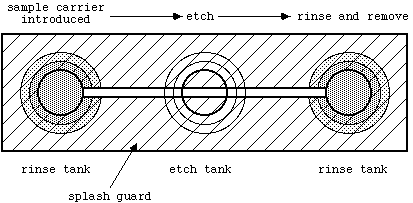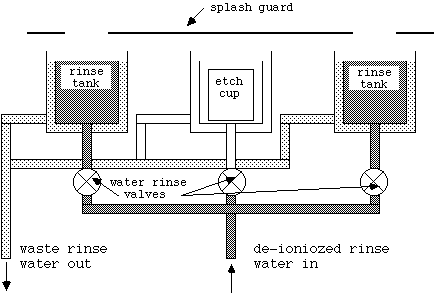Hydrofluoric Acid Etching
As discussed in the Safety section of the
Lab Manual Introduction, hydrofluoric (HF) acid can be very dangerous if
mishandled. It is, however, a very useful etch for silicon dioxide, SiO2.
It has a number of advantages over other techniques when patterning SiO2
over silicon: it has very high selectivity over silicon, i.e. the etch rate
of SiO2 in HF is much greater than the etch rate of Si; HF can
easily be masked by photoresist; the etch rate is quite repeatable, and
remains constant even after a large number of samples have been etched;
and the equipment required to etch with HF is relatively simple and inexpensive.
The actual etchant we use is a solution of concentrated HF (49%), water,
and a buffering salt, NH4F, in about the ratio 1:6:4. This solution
is referred to as buffered HF, or BHF (also see the MSDS
for BHF). The buffering agent is added to maintain a constant pH as the
HF is consumed in its reaction with SiO2:
4HF + SiO2 => SiF4([arrowdblup])
+ H2O
Since the etch rate is a function of the solution pH, BHF has a much more
controlled etch rate (about 1000Å/min at room temperature) over the
life of the etchant.
In order to safely handle our BHF etching a special etch station has been
designed for our lab. Figure 1a shows a top view of our station, and Figure
1b shows the plumbing arrangement for the station.

Figure 1a: top view of BHF etch station.

Figure 1b: Plumbing diagram for BHF etch station.
Our system consists of three dump-type rinse tanks installed in the work
top of a fume hood. Each tank has a DI water supply, controlled by a water
valve in front of the station. The tanks are made up of an inner cup to
which the water is supplied; this cup fills until it overflows into the
outer portion of the dump tank, which is connected to an acid drain. We
use the first tank on the left for an introduction rinse to wet the samples
to be etched; the middle tank holds a teflon etchant cup, which actually
contains the BHF; the last tank on the right is used for a water rinse to
remove the BHF.
In addition to the dump tanks we use a special splash guard to prevent accidental
acid spills. This consists of a plexiglass cover with large openings above
the two end rinse tanks. These openings are connected by a narrow slot which
passes over the etch cup (see Fig. 1a). To begin an etch step, the substrates
to be etched are placed in a teflon chip carrier with a long handle attached.
This carrier is then lowered into DI water through the opening over the
first rinse tank. After wetting the samples the carrier is raised and transferred
to the etch cup. The slot in the splash guard is large enough to allow the
handle to pass through, but is not large enough to allow the chip carrier
to be removed. When the etch is finished, the carrier is raised clear of
the etch cup, and is transferred to the final rinse tank. After a suitable
rinse time the chip carrier can be removed through the large hole in the
splash guard over this tank. We have found this system will prevent HF splashing
in almost all circumstances.
BHF ETCH PROCEDURE
1. Place samples to be etched in the teflon carriers located on the
bench to the left of the etch station. Make sure a long teflon handle is
inserted into the carrier.
2. Turn on the water supply to the two end dump tanks; make sure the two
regular water faucets are on and running into the sink.
3. Put on a pair of acid resistant gloves (the green gloves next to the
hood) and a pair of protective eye glasses. DO NOT LEAVE THE HOOD AREA ONCE
YOU START THIS PROCEDURE!
4. Carefully lower the sample carrier through the splash guard into the
left-most rinse tank. Leave immersed for approximately 15 sec.
5. Lift the carrier out of the rinse water, and carefully shake off any
excess water. Now slide the handle down the slot to position the wafer carrier
over the BHF cup. Very carefully lower the carrier into the cup.
Be sure not to splash any HF out of the cup.
6. Use the running water in the sink to thoroughly rinse your gloves. DO
NOT REMOVE YOUR GLOVED HANDS FROM THE HOOD DURING THE ETCH TIME: REMAIN
AT THE ETCH STATION UNTIL THE PROCESS IS COMPLETE.
7. At the end of the desired etch time carefully lift the carrier out of
the etch cup, and gently shake any drops of BHF off the carrier back into
the cup. Now transfer to and immerse the carrier in the right side rinse
tank. RINSE FOR AT LEAST 1 MIN.
8. Use the HP H2O dispenser to rinse the handle of the carrier,
as well as your gloves. MAKE SURE ANY SURFACES THAT MAY HAVE BEEN CONTAMINATED
WITH HF ARE RINSED IN WATER.
9. Remove the carrier from the rinse tank, and finish with at least two
HP H2O rinses in the teflon beaker in front of the etch station.
10. After completing the rinse remove the carrier from the hood, and transfer
to the wafer spinner. Go back to the hood and thoroughly rinse your gloves
in running water in the sink. Remove acid gloves, leaving them at the hood.
11. Remove your clean gloves, throw them away, and go to the large sink
in the Litho Room for final wash up. Be careful to rinse your hands and
arms thoroughly, especially under the fingernails.
Return to the IC Fab Lab TOC